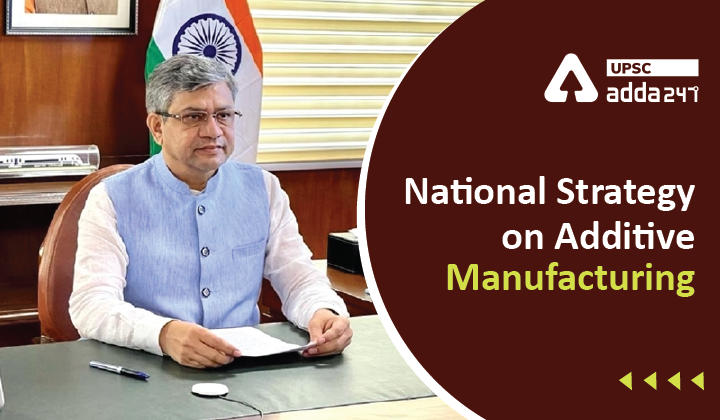Table of Contents
National Strategy on Additive Manufacturing: Relevance
- GS 3: Achievements of Indians in science & technology; indigenization of technology and developing new technology.
3D printing: Context
- Recently, Ministry of Electronics & IT (MeitY) has released a “National Strategy on Additive Manufacturing” to cater next-generation digital manufacturing and mitigate immediate disabilities of local industries.
National Strategy on Additive Manufacturing: Key points
- The national strategy would postulate the tenets of ‘Make in India’ and ‘Atmanirbhar Bharat Abhiyan’ that advocate self-reliance through technological transformation of the production paradigm.
- The aim will be realized through a dedicated National Centre with the participation of all stakeholders.
- This centre will act as an aggregator of knowledge and resources to accelerate technology adoption and advancement.
- The sector specific Centres will also be created to infuse indigenous AM technology to offer Indian manufactures an edge over global peers.
- Manufacturing sector is an important part of the vision for $1 trillion Digital Economy.

3D manufacturing policy: Objectives
- The policy aims to increase India’s share in global additive manufacturing to 5 per cent by 2025.
- As per the National Strategy for Additive Manufacturing, by 2025, India will aim to achieve certain targets such as 50 India specific technologies, 100 new startups for additive manufacturing, 500 new products and 10 existing & new manufacturing sectors.
- The policy hopes that these new startups and opportunities will give jobs to at least 1 lakh new skilled workers over the next three years.
- MeitY hopes that the policy could likely add $ 1 billion to the gross domestic product by that time.
- It will create intellectual property & export opportunities in the country.
3D printing benefits
- The strategy document has been formulated to promote all sub-sectors, such as machines, materials, software and design, within the Additive Manufacturing.
- The strategy will further accelerate the adoption of untapped potential business opportunities.
- It will also strengthen the execution of recommendations laid in the National Electronics Policy, 2019.

What is additive manufacturing?
- 3D printing or additive manufacturing is a new generation technology which uses computer-aided design to make prototypes or working models of objects by laying down successive layers of materials such as plastic, resin, thermoplastic, metal, fiber or ceramic.
- With the help of software, the model to be printed is first developed by the computer, which then gives instructions to the 3D printer.
- Additive Manufacturing is next generation of digital manufacturing that allows the intersection of Computing Electronics, Imaging & the emerging areas of Artificial Intelligence and pattern recognition.
Additive manufacturing in India
- Additive Manufacturing (AM) has immense potential to revolutionize India’s manufacturing and industrial production landscape through digital processes, communication, imaging, architecture and engineering.
- With the release of the 3D manufacturing policy, Innovation and R&D ecosystem will be encouraged in PPP mode to transform existing research knowledgebase of India.
- The strategy will help develop additive manufacturing products for vast domestic and international market in various sectors including electronics, photonics, medical device, agro and food processing etc.
Read recent news for UPSC
| Non Banking Financial Companies (NBFC) | GOBAR DHAN Scheme: PM Inaugurates Asia’s Biggest Biogas Plant | MILAN 2022 | Annual Frontier Report 2022 |
| Jal Jeevan Mission | Har Ghar Jal by 2024 | Financial Stability and Development Council | Draft India Data Accessibility and Use Policy 2022 | Ramanujan Prize for Young Mathematicians |
| Border Infrastructure and Management Scheme | India’s stand on Russia-Ukraine Conflict | Policy on Synthetic Biology | Vigyan Sarvatra Pujyate | Dhara- an Ode to Indian Knowledge System |
| International Mother Language Day | International Mother Language Day 2022 | Minsk Agreements and the Russia-Ukraine Conflict | Purple Revolution and Aroma Mission | Extended Producer Responsibility: Government Notifies New Guidelines |



 TSPSC Group 1 Question Paper 2024, Downl...
TSPSC Group 1 Question Paper 2024, Downl...
 TSPSC Group 1 Answer key 2024 Out, Downl...
TSPSC Group 1 Answer key 2024 Out, Downl...
 UPSC Prelims 2024 Question Paper, Downlo...
UPSC Prelims 2024 Question Paper, Downlo...




